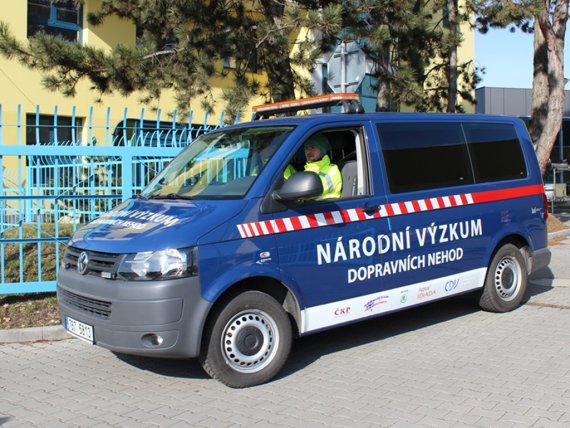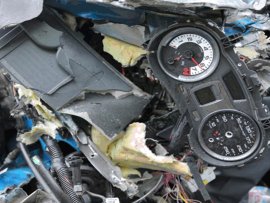In-depth analysis of traffic accidents
Every year, statistics of traffic accidents in Czechia are tragic and they have fallen significantly short of the development in other European countries with more advanced roadway systems. Every year, hundreds of people die on the roads, and tens of thousands of others are slilghtly or severely injured. One moment can change your entire life. It does not have to be that way.
One method of active approach to improve the accident rate is research which:
- Helps objective identification and analysis of accidents and later aids to resolve the locations of frequent accidents,
- Obtains detailed knowledge on the mechanism of occurence of an accident, as well as of its entire progression and consequences, especially focusing on finding out the primary causes of its origin.
- The data analysis is inpedendent of the police investigation, medical services and fire brigade actions.
Who conducts the investigation at the site of the accident?
- A transport infrastructure specialist,
- An automobile engineering specialist,
- A traffic psychologist.
On the spot, they gather all data related to the accident. They know about the event thanks to cooperation with the Czech Police and units from the integrated rescue system, who they are subject to at the site of the accident.
Which areas does the traffic accident research concern?
Transport infrastructure
At the site of a traffic accident, the transport infrastructure specialist documents the specific stretch of the road completely in photos and makes videorecordings of the directions of the arrivals of the participating vehicles.
At the site of a traffic accident, the transport infrastructure specialist records:
- Parameters of the location of the accident (range of vision, surroundings, height, width, directional conditions, etc.),
- Road surface (type and quality),
- Traffic signage,
- Placement of vehicles, braking, skidding and other traces,
- Weather and traffic conditions and others.
The site of the accident and the relative placement of the traces are geodetically located. Based on the obtained data, an electronic plan of the location is created using special software. That is then used to run simulations of the accident.
Automobile engineering
The job of the automobile engineering specialist is to photographically document the deformations of the vehicle's exterior in detail. For that, the engineer uses measuring rods and a laser 3D scanner. The engineer also documents the placement of individual control elements and deformations in the vehicle's interior.
The inspection of the vehicle's exterior includes i.e.:
- Detecting the extent of the deformation of the vehicle,
- Measuring the technical parameters of the vehicle after the accident: length, width, height of the vehile, tire pressure, and their comparison to the manufacturer‘s technical parameters, etc.
The inspection of the vehicle's interior includes:
- Airbag activation check,
- Seatbelt condition check,
- Determination of the extent of the deformation of the dashboard, steering wheel and others,
- Checking the functionality of individual interior parts and safety features at the moment of the accident and their functionality after the accident.
Human factor and psychological part
To manage the first critical moments right after the accident, specially trained psychologists help the victims. The object of te psychologist is to primarily establish a friendly atmosphere and the psychological stability of the individual.
Early psychological help reduces the negative symptoms, which may – if not dealt with – end in post-traumatic stress disorder for the participants of the accident.
Accident investigation focusing on the human factor includes:
- Providing crisis intervention,
- An interview between the psychologist and the participant of the accident,
- Participant's thoughts on the conduct of the vehicle in the critical situation,
- Participant's thoughts about the possibility to avoid the accident etc.
Health part
After the accident, the experts (with the consent of the participants of the accident) get information about the condition of their health. All medical data about an injured person are anonymous, and the only identifier is the number of the accident in the database. Health data are essential for a complex analysis of the mechanism of the accident. Information about the participants' injuries may also be relevant e.g. for the development in the area of vehicle design.
What has the research shown so far?
Most accident are caused by people.
The cause is usually their inattention, inadequate speed, incorrect evaluation of the situation, alcohol, inexperience, tiredness or microsleep. Factors also worth noticing are known disobedience to traffic rules, panicked reactions, risky overtaking, health indisposition or the influence of medication.
The results of the research may initiate the introduction of:
- Precautions in the area of prevention, either for BESIP or the Czech Police,
- Psychological rehabilitation programs for drivers whose licenses were suspended and who commit offenses repeatedly,
- Defensive driving education for drivers, e.g. using a driving simulator.
The origin of an accident may also lay in the design of the location.
Examples of most frequent faults:
- Inappropriate arrangement of crossroads,
- Poor condition (e.g. improper roughness) or downgrade of a road,
- Improper placement or construction of a crosswalk,
- Insufficient lighting of a crosswalk./li>
Dangerous solid obstacles may contribute in making the consequences of accidents worse, such as posts, trees, concrete culverts and others.
Nevertheless, cca 30-35% of critical places may be fixed in a relatively short time. Often, this would require simple, cheap precautions. Sometimes, only a couple of meters of safety fence would be enough for the accident to not end in tragedy. Therefore, the accident in-depth analysis team informs local self-governments or governors of the roads about its findings, and it recommends what can be altered, as well.
Automobile designers can learn from accident research results, as well.
Nowadays, vehicles are equipped with a vast array of effective safety elements, but there is still a lot to improve.
Accident in-depth analysis data are used by vehicle manufacturers e.g. for the testing of new systems. The manufacturer may, in this way, test their behaviour in real traffic.




Long-term cooperation with the Czech Police
The Transport Research Centre has cooperated very closely with the Czech Police traffic department for a long time. An example of this might be the Ministry of Interior‘s project titled HASDN (an In-depth analysis of road traffic accidents), which took place between 2011 and 2015.
Hloubková analýza dopravních nehod [ 4.03 MB]
The results of accident analysis inspired us for new patents.
New headrest
In modern vehicles, the headrest is a sure thing. Its main purpose is to protect the cervical spine during an accident, which it manages well in case of impact from the front or from the back. The problem, however, occurs when the impact comes from the sides, under an angle, or during the rotation of the vehicle. In these cases, the headrest is not able to hold the head and protect the cervical spine from excessive bending.
Více informací ke stažení: Nový typ opěrky lépe ochrání vaši hlavu i krční páteř [ 2.97 MB]
Mobile measuring device for the detection of longitudinal coeffiecnient of friction of the road surface
Aids an objective investigation of accidents and also their prevention.
Více o mobilním měřicím zařízení [ 1.97 MB]
Contact
V případě zájmu nás neváhejte kontaktovat na e-mailu:Více informací: vyzkumnehod.cz
Fotogalerie










